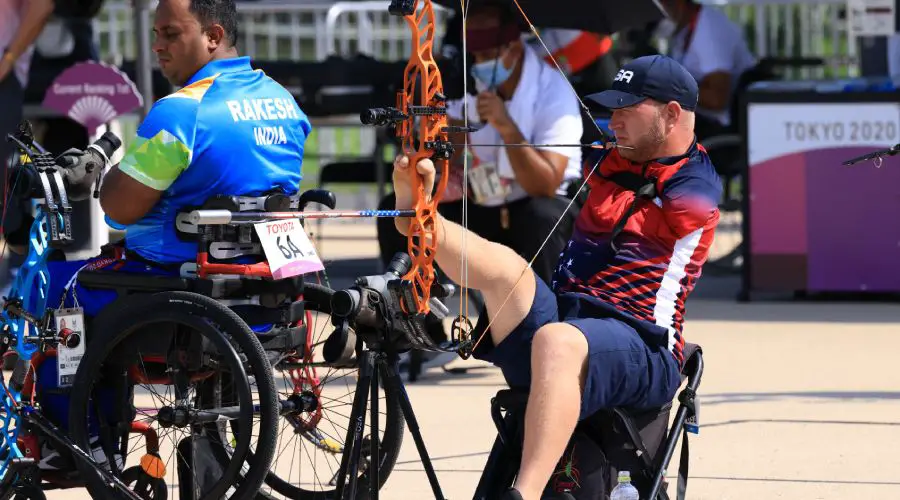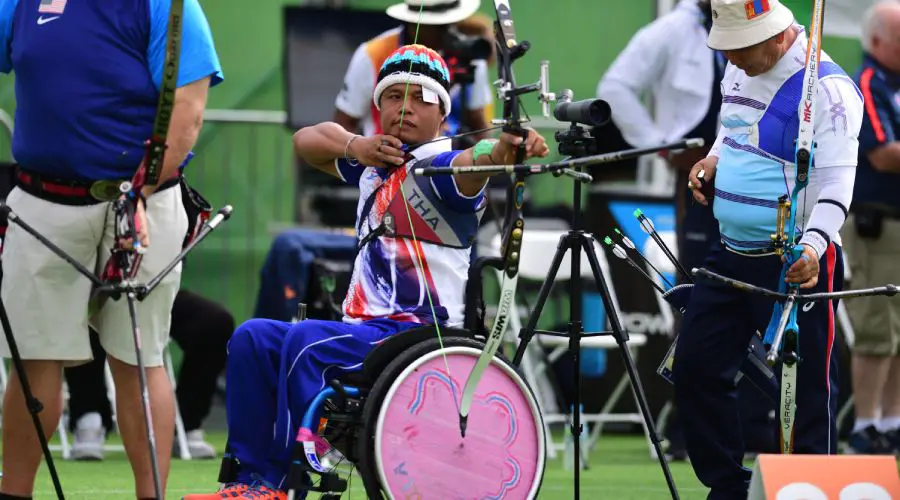The rules of paralympic archery are very similar to conventional sport, except for a few adaptations for the athletes’ needs. This engaging sport not only challenges archers to hit targets with mastery, but also incorporates a unique complexity of rules and regulations that shape each competition.
From the categorization of archers to the scoring criteria and the equipment allowed, the rules of Paralympic archery reflect a commitment to fairness and the safety of those involved.
In this comprehensive guide, we will explore the rules of paralympic archery in detail, offering a clear understanding of the sport.
Participate in our free WhatsApp community and receive daily tips, news and trivia from over 50 sports! Click here to join.
Rules of paralympic archery: objective
The objective of Paralympic archery is to hit targets with precision, aiming for the center of the target to score as many points as possible. Competitors must demonstrate skill, control and concentration to shoot their arrows accurately and consistently.
The idea is quite simple: the winner of an archery match is the archer or team that accumulates the most points over the course of the competition, which is determined by the sum of the scores of each arrow shot at the targets. Below, we’ll take a closer look at paralympic archery scoring.
Rules of paralympic archery: targets and scores
The targets are usually divided into colors to indicate different scores. Although the colors may vary depending on the specifications of the competition, they generally follow a common pattern. The target is placed at a distance of 70m and is 1.22m in diameter, made up of ten circles.
See the paralympic archery scores:
- Center (10-Ring or X-Ring): yellow. Maximum score, usually 10 points.
- First Ring around the Center: yellow. Score of 9 points.
- Second Ring around the Center: red. Score of 8 points.
- Third Ring around the Center: red. Score of 7 points.
- Fourth Ring around the Center: blue. Score 6 points.
- Fifth Ring around the Center: blue. Score of 5 points.
- Sixth Ring around the Center: black. Score of 4 points.
- Seventh Ring around the Center: black. Score of 3 points.
- Eighth Ring around the Center: white. Score of 2 points.
- Outer ring (variable size): white. Score of 1 point or no score, depending on the competition rules.

Rules of paralympic archery: classes
In addition to the Paralympic archery scores, you have to pay attention to the categories, which are determined by the archer’s ability to stand and/or move using their arms and torso:
- W1 Arch
- W2 Arch
- OPEN (recurve bow)
- OPEN (compound bow)
- Arch V1
- Arch V2
- Arch V3
Recurved Arc
Recurve bows are characterized by curved limbs that create a “recoil” when the rope is pulled. Athletes with disabilities in one or two limbs (upper or lower) take part in this category.
Archers may use recurve bows and arrows that comply with World Archery and International Paralympic Committee (IPC) regulations. The equipment must comply with the specifications established for the Paralympic Recurve Bow category.
The total length of the recurve bow, measured from the end of the upper blade to the end of the lower blade, should generally not exceed 163 centimeters. This length limit is designed to ensure that all archers have comparable equipment and to promote fair competition.
Composite Arc
Similarly, the compound bow in Paralympic archery also involves athletes with disabilities in one or two limbs, upper or lower.
Compound bows have a pulley system which helps to reduce the force needed to hold the drawn string. The total length of the compound bow, measured from the end of the handle to the end of the blades, usually varies between 76.2 and 101.6 centimeters.
W1 Bow
The W1 bow categoryis aimed at archers with more severe functional limitations in the upper or lower limbs, such as severe paralysis or amputations that require the use of wheelchairs.
Archers in the W1 bow category are allowed to use additional equipment, such as supports or braces to ensure stability while shooting.
W2 Bow
A category very similar to W1, the W2 Bow involves archers with fewer functional limitations in their upper limbs. In practice, this means that they can also use wheelchairs, but have greater functionality in their upper limbs compared to those in the other category.
Open Bow V1, V2 and V3
In the Open Bow V1, V2 and V3 categories, visually impaired athletes take part. To make this possible, the archers have the help of a tactile mark on the bow.
Rules of paralympic archery: teams
The rules of Paralympic archery involve contests in three ways:
- Individual
- Double
- Team
In the case of the team competitions, each team has three goalkeepers.
Rules of paralympic archery: phases
In paralympic archery, as in conventional sport, the competition format involves phases that determine the winners throughout the event:
- Qualifying Phase: archers compete to obtain an initial score that will determine their position in the overall ranking.
- Preliminary rounds: based on the results of the qualification phase, the archers are placed in direct elimination brackets. The archer with the highest score in a given round advances to the next phase.
- Final Stage: after the qualifying rounds, the best goalkeepers and teams advance to the final stages of the competition. This can include quarterfinals, semifinals and finals.

Paralympic archery rules: eligible disabilities
The disabilities eligible for an athlete to fall within the Paralympic archery rules include:
- Paraplegia
- Tetraplegia and equivalent
- Amputation and equivalent
- Cerebral palsy
- Dysfunctional diseases (such as muscle atrophy and sclerosis)
- Joint dysfunctions
- Back problems
- Multiple disabilities
- Visually impaired (but does not enter the Paralympic Games)
Now that you’re up to date with the rules of Paralympic archery, it’s worth finding out more about the Paralympic Games and their disciplines. Follow the content available on our website:



